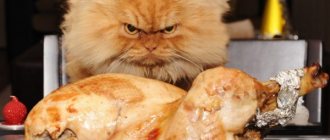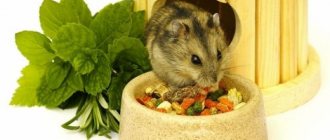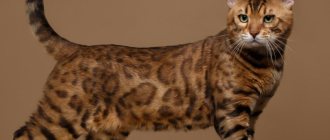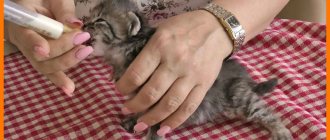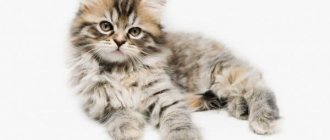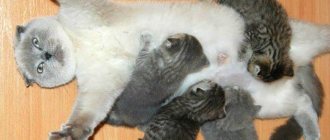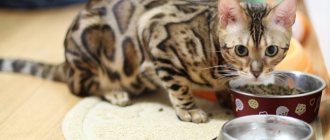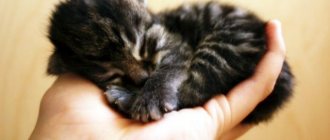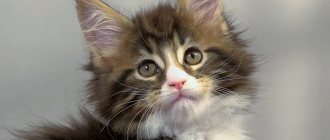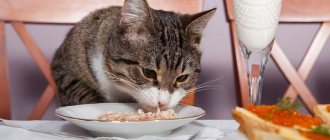Veterinarians believe that baby food for cats is healthy if it does not contain flavor enhancers, starch, vegetables or spices that are exotic for the animal. Meat and vegetable gruels, as well as infant formula, are suitable for feeding babies. It should be taken into account that the product for children contains an increased concentration of fats, oils, minerals and vitamins, which can cause obesity or hypervitaminosis in the animal. Therefore, you need to accurately measure the volumes and give your baby food according to a strict schedule.
Food for a baby kitten
The needs of kittens and newborn babies for nutrients, vitamins, and minerals are quite different. However, there are times when infant nutrition becomes a real salvation for four-legged babies.
To feed a pet, baby food is used in several cases:
- when feeding suckling kittens left without a mother. The infant formula is diluted with boiled water in a ratio of 1/1. Feed the baby from a pipette or syringe;
- if your cat is sick or allergic to cat food, baby food will be a nourishing and safe substitute;
- as a nutritional supplement that diversifies the home menu of an adult animal and a baby.
Choose meat and vegetable purees in jars without salt, onion, garlic, as they are harmful and will not be digested by your baby kitten. Agusha puree, which does not contain salt or starch, is perfect for fluffy.
Important!
New food should be introduced into the diet of a four-legged baby with caution. Carefully observe how the kitten behaves, how it goes to the litter tray, and what its mood is. Is he cheerful and playful? Complementary feeding is appropriate.
This is interesting: What to feed a cat with urolithiasis
About feeding kittens
Let us immediately determine that a blind kitten on the street, even if it is in a box and covered with a cloth, is a non-resident. If you find such a find, the decision is yours! Feeding kittens is a big responsibility and literally sleepless nights.
The only chance to save a newborn kitten that is not fed by a cat is a person. Even if you decide that you cannot help your baby, there are some things you can do:
- Try to find someone who can pay attention to feeding, taking the kitten for a while. Going to a clinic where the kitten will be euthanized - you may think that this is cruel, but is a slow, starving death more humane?
The next important point is the chances of survival. If you take on feeding babies that have been rejected by a cat, that is, they were warm, were not injured, etc., the chances of survival are higher. If you find a blind kitten on the street, you should be prepared for the fact that it may die due to:
- Hypothermia. Too much hunger. Received injuries.
Note! Cats are very good mothers and they rarely abandon their offspring, but if this happens, the babies need to be shown to a doctor.
The fact is that a cat can leave offspring if they are not viable, for example, premature. In this case, if you decide to feed orphan kittens, all the risks and scenarios will be known to you in advance.
The chances are very low for kittens that have not developed a sucking reflex or the digestive process has stopped . A stop can happen for two reasons:
- The kitten has been starving for too long. The kitten has never suckled milk; in fact, in this case, digestion has not yet started and the chances of survival are higher.
The absence of an oral reflex is almost always tantamount to doom. A kitten may refuse to suckle if the reflex is not yet developed (prematurity) or if it is too weak (precomatose or lethargic).
Tip: In the early stages of lethargy, a kitten can be brought back to consciousness by warming it up and vigorously (but gently) rubbing the body from the limbs to the heart.
So, you have a newborn kitten, what should you do first? Decide what and how to feed. We will talk about choosing the type of feeding below; there are several answers to the question of what to feed:
- A syringe without a needle is not the most convenient method, but it will work as a temporary solution. A pipette is also not the most convenient method, since the kitten knows how to suck, not lick. A syringe with a rubber nozzle - a rubber band from a pipette, a piece of tube from a dropper or a rubber catheter is put on the hard nose of the syringe. The kitten will be able to suck the rubber nozzle, and with the help of the piston you will be able to conveniently control the flow of milk. Just one caveat - make sure that the kitten does not suck in the nozzle; it must hold securely. Container for drops for the nose, ears, etc. - the tube must be thoroughly rinsed, doused with boiling water and make sure that there are no foreign odors left in it. A special bottle for feeding kittens - like a baby bottle, with a nipple, only much smaller.
Important! The kitten must suck, that is, make an effort to get milk. If you simply pour the mixture into your baby's mouth, he may lose his sucking reflex.
Natural diet
What your cat will have to give up forever if she has kidney failure is dairy products. They are strictly contraindicated for this disease. Fish, any kind, should also be included in the category of prohibited ingredients. The thing is that it contains a lot of phosphorus, and its excess is harmful for cats in such a situation. Porridge, bread - any carbohydrates are recommended to be removed from the daily menu of a sick cat. But it’s worth including vegetables in it.
If you previously gave your furry creature vitamins and various dietary supplements, do not rush to feed them to your cat yourself now. Consult your veterinarian first. Believe me, sometimes even vitamins, if they are given in the wrong composition or volume, can harm the animal.
Kidney failure in cats is a reversible and sudden disorder of the kidneys' excretory function when they suddenly stop producing urine. As a result, harmful metabolic products accumulate in the body, and the usual balance in the functioning of systems and organs is lost.
Urinary system of a cat
Causes
There are acute and chronic renal failure in cats. The course depends on the cause of origin, as well as the speed of development of symptoms. The whole variety of factors leading to the development of the disease is usually divided into two categories: renal and prerenal.
Real reasons:
- the action of toxins coming from outside,
- allergic effects of certain medications, for example, sulfonamides,
- infectious processes affecting the excretory organs.
Prerenal factors are directly related to dehydration of the body and destruction of red blood cells, which, for example, is observed during infection with leptospirosis or blood parasites.
Attention! During kidney failure, a cat's blood circulation in the kidneys is disrupted, they do not receive oxygen and the cells undergo necrotic decay.
Acute form
Despite the wide variety of cause-and-effect factors, the symptoms of acute renal failure in a cat are the same. At the beginning of the inflammatory process, signs characteristic of the underlying disease are observed. But soon they are mixed with kidney disorders, which can lead to death.
Thirst in kidney failure
Conventionally, the course of the disease can be divided into four successive stages:
- initial,
- anuric (cessation of urine excretion or excretion in negligible quantities),
- restoration of urination,
- recovery.
Let's look at all the stages in more detail.
Stage I. Symptoms of the initial stage may go unnoticed, since during this period the signs of the underlying disease will predominate.
But at this time, changes are already taking place that are imperceptible at first glance: blood circulation in the kidneys is disrupted due to shifts in hemodynamics (pressure jumps, heart function speeds up or slows down, etc.).
The stage lasts from several hours to several days.
You should know it! Hemodynamics is the movement of blood through the vessels.
Stage II. The anuric or oliguric stage is the manifestation of typical signs of renal failure in cats; characterized by cessation of diuresis and increasing signs of uremia:
- drowsiness,
- lethargy,
- immobility,
- diarrhea,
- high blood pressure,
- rapid heartbeat,
- swelling,
- muscle cramps,
- the heart may stop.
You should know it! Uremia is poisoning with urea and nitrogenous compounds (protein breakdown products) that are not removed from the body in the urine.
If urine continues to be released, it is thick, bloody, with visible sediment.
There are two options for further developments: death or transition to the recovery stage.
Stage III. The diuretic stage consists of restoring urine production and removing it from the body. This usually happens on the 7th day from the appearance of the first signs.
It is important to understand that at this stage, kidney function has not yet been sufficiently restored, so there may even be an increase in urination. In this case, the urine will be less concentrated than at the physiological norm.
Stage IV. The recovery stage is protracted and can last several months.
Chronic form
Symptoms of chronic renal failure in cats increase gradually, which is associated with the slow death of nephrons. Pathology develops against the background of diseases of the urinary system, diabetes mellitus or heart failure.
You should know it! A nephron is a kidney cell, a kind of filter that separates necessary metabolic products from toxic ones.
Drowsiness and lethargy
Just like in the acute form, there are four stages:
- hidden - there may not be obvious signs, except that the animal drinks a lot of water, rests often and for a long time;
- compensatory - at this stage the amount of urine excreted increases,
- oliguric is manifested by an increase in signs of uremia, while the animal may begin to feel much better, and then a deterioration in the condition is observed again.
- thermal - the final stage is characterized by lethargy, the appearance of swelling and itching. A gray coating is visible on the tongue, diarrhea is common, the amount of urine produced is very small or does not come out at all. The smell of acetone and urine can be heard from the animal at a distance.
In the last stage, other organs often malfunction: heart, lungs, endocrine glands.
Important! All changes that occur during the thermal stage of the disease are irreversible! In this case, the prognosis for a cat with renal failure is unfavorable!
Diagnostic issues
Despite such serious changes occurring in the body, recognizing the disease can be problematic even for an experienced specialist, not to mention the average person. To make a diagnosis, it is necessary to collect as complete an anamnesis as possible. Next, his data is compared with the clinic and the results of biochemical studies of urine and blood.
You should know it! Anamnesis is a kind of investigative measures that help to find out the cause of the disease. Information is collected based on a survey of the pet owner.
During the survey they find out:
- Does the animal have kidney problems and what kind?
- was it possible that there was poisoning?
- When did the decrease in urination begin?
They also evaluate edema and its nature, listen to the heart to identify murmurs.
The laboratory must carry out:
- general urine analysis,
- analysis for protein, urea, chlorides and sugar in urine,
- investigate the composition of the sediment,
- blood is checked for acid-base balance.
Only based on the entire range of studies conducted can we draw a conclusion about existing kidney problems.
Therapeutic measures
Naturally, with kidney failure in cats, the question comes to the fore: how to save the animal? In fact, the answer is not so simple. All treatment and its result will depend on the cause of the disease, its severity and the presence of concomitant diseases, as well as possible complications.
Drugs for deficiency
As for the therapeutic scheme, it has two directions:
- relief of the underlying disease,
- eliminating signs of deficiency.
The owner is required to provide the animal with peace. It is important that the room is warm and well ventilated, which will facilitate the work of the heart, reduce the breakdown of proteins and eliminate vascular spasm.
It is equally important what to feed a cat with kidney failure. The feeding regimen should be dietary, and salts and liquids should be excluded from the diet in the presence of edema.
The complex of all measures should be aimed at stimulating kidney function and eliminating symptoms:
- The use of antibiotics is indicated, against which a novocaine perinephric blockade is performed.
- To restore diuresis and replenish fluid, droppers with sodium chloride based on glucose are placed. Glucose has beneficial properties: improves metabolism, relieves intoxication and increases the antitoxic function of the liver, helps normalize heart function, and improves diuresis.
- They also eliminate the symptoms of cardiovascular diseases and direct all efforts to restore kidney function.
- In particularly severe cases of the disease, it is necessary to resort to peritoneal dialysis.
Drugs that can improve a pet’s condition during the treatment of kidney failure in cats include vitamins, especially A, D and E:
- vitamin A - restores capillaries and the functioning of the endocrine glands, increases the body’s resistance, forcing it to work independently,
- Vitamin D restores mineral metabolism, which is very important in such conditions,
- Vitamin E - increases protein utilization.
Medicinal food for cats with kidney failure has long appeared on the shelves. Perhaps they really correspond to the diet that should be followed for this disease.
Attention! There is one important addition: the finished product must be ideal for a specific pet, and in mass production it is not entirely correct to talk about an individual approach.
Diet for kidney failure
A diet for a cat with kidney failure can only be selected with the help of a veterinarian. Its main principles:
- reducing protein intake - its amount should not exceed the minimum requirement,
- Dry food, especially cheap economy food, is excluded from the diet,
- Canned fish should also be excluded - they are rich in phosphorus, which is contraindicated in large quantities for this disease,
- Naturally, there can be no question of food from the table, especially smoked and pickled foods.
It is clear that selecting the components of the diet is problematic, so many experts advise the owners of their patients to use Renal food.
It is designed specifically for sick cats with kidney disease and renal failure and has proven itself to be one of the best. According to the manufacturer, the medicinal food contains an optimal set of essential substances and is also enriched with antioxidants that help neutralize and eliminate harmful metabolic products.
All preventive measures consist of preventing the development of kidney diseases, as well as their timely treatment. They also pay attention to first aid for pathologies that may contribute to kidney failure, which will be a kind of prevention.
How to dilute baby formula for a kitten
Owner's instructions:
- We need to prepare the water. It must be boiled and left to stand. But ideally, it is better to pass boiled water through a filter (a regular pitcher will do). This will rid the liquid of scale particles. You can also use bottled water for children 0 to 3 years old. Before use, it is heated to 37°C.
- After this, pour the dry mixture into the water in a thin stream and mix thoroughly, ensuring that there are no lumps in the resulting “milk”.
- The mixture should be taken 2 times less than indicated in the instructions. For example, if you rely on 50 ml of water to take 10 grams, then for a kitten you need to dilute only 5 grams. All numbers are approximate, you need to read the instructions for the specific mixture!
Expert opinions
Veterinarians often argue, citing their observations and beliefs as evidence:
- some argue that children and kittens have different digestive systems, so what is designed for the human body should not be used for cats;
- others refer to the considerable experience of cat owners, because they have raised more than one generation of purrs. Their artificially fed kittens are practically no different in appearance from their relatives in development. They play just as happily, eat with appetite and are completely healthy, thanks to this complementary feeding.
Features of feeding
First you need to learn about some of the characteristics of the kittens’ body, as well as the intricacies of feeding. Everyone knows that newborn kittens in the first month of their life should eat exclusively milk. Of course, ideally, the cat herself should feed the kitten, but this is not always possible. Therefore, the first thing that comes to mind is to feed a newborn kitten with baby food.
You need to choose only the mixture that is intended for newborns.
After the first feeding with such food, it is imperative to monitor the reaction of the kitten’s body and its behavior. If after the first feeding the pet feels good, does not worry, falls asleep normally and is active when waking up, then this is good. It is also important to monitor his stool: it should be normal, without any strong odors. If everything is in order, then you can continue to feed the kitten with the selected mixture.
If the animal becomes lethargic, constantly suffers from abdominal pain, the stool has a strong odor, there is mucous discharge or even streaks of blood, then you need to choose a different diet.
You cannot choose a mixture with various additives for feeding a small pet. For example, there are infant formulas intended for three to four month old babies that contain cereal additives. There are also formulations with the addition of honey or even sugar. This type of food is absolutely not suitable for a kitten.
This is interesting: Can cats eat shrimp?
What to feed a kitten?
It's time to figure out what to feed the kitten. Naturally, the best option is to find a nursing cat who will accept the orphan. Before the invention of cat milk replacers, newborn kittens (and puppies) were fed cow's or goat's milk.
- Goat's milk was considered a better option because it contains more lactobacilli.
- Cow's milk has never been recognized as a good means of feeding, but there were no particular alternatives. Today, cow's milk is categorically not recommended for feeding kittens, and goat's milk is encouraged to be diluted with water in a 1:1 ratio.
Note! If you feed your kitten cow's or goat's milk, monitor the condition of its skin and stool. The fact is that the baby may be allergic to lactose in foreign milk, and it is very difficult to notice.
Infant formulas are successfully used to feed newborn kittens, but:
- Make sure there is no sugar in the mixture.
- Choose a formula “from scratch”, that is, for newborns, and not two- or three-month-old children.
- If you were unable to buy a “from scratch” mixture, make sure that the selected product does not contain additives (berries, honey, cereals).
- Dilute any baby formula with twice as much water as indicated in the instructions.
- Store the mixture only in the refrigerator.
- Do not feed formula that was prepared more than 24 hours ago.
The best choice would be a special mixture - a cat's milk replacer. This powder must be diluted according to the instructions and dosed according to the recommendations given on the package. Using a cat milk substitute significantly reduces the risk of allergies, although it does not eliminate it.
Note! Grown-up kittens can be fed with meat baby food, without the addition of fruits, sugar, potatoes, broccoli and other unnatural for a cat's diet.
What food is suitable for Scottish kittens?
Are you the proud owner of a Scottish kitten and are wondering what food is best for your pet? The fact is that for the harmonious development of a baby of any breed, the features of choosing food are the same.
Today there are many developers of food for cats. Store shelves are bursting with an abundance of products. In such conditions it is easy to get lost. But the choice of manufacturer should be taken extremely seriously. Ready-made food for Scottish kittens must be balanced and contain all useful vitamins, minerals and trace elements. To do this, before purchasing a product, you need to study its composition. The main condition for high quality feed is the meat content in it. This ingredient should be in the first place in the composition. If everything is in order with this, then we study the vitamin content.
It is recommended to choose super-premium and holistic food for Scottish kittens. Each manufacturer's product line includes products in this category, but the developers themselves are different. In any case, your cat should evaluate the food you choose. If he feels good after eating, then the product is suitable for him.
Baby food
Formula milk for newborn babies is as close in composition as possible to a woman's breast milk. They are mainly made from cow's milk. To ensure that the child’s body easily absorbs nutrition, milk protein is changed and dry formulas with different degrees of preparedness are obtained:
- adapted. The most complete nutrition for babies is used from birth to 6 months;
- partially adapted.
Properties similar to breast milk, but do not contain minerals and essential fats, are suitable for children after 6 months; - low-adapted.
The composition is obtained from whole cow's milk with the addition of sucrose and starch. Give to babies after one year.
Infant formulas made with goat's milk have also recently appeared on the domestic market. This option is good for newborns who are allergic to cow products.
Question
: from birth to one year, the choice of options for infants is large, but what to choose for mustachioed suckers?
Suitable nutrition and care
To feed kittens, choose adapted mixtures from goat or cow's milk, they are also called “from scratch”, that is, for children from birth to 1 month. The desired product should not contain sugar or additives (salt, palm oil, grains).
Please read the instructions for use first. Then dilute the powder with twice the amount of warm, clean, boiled water than is written in the recipe. Diluted food will not cause constipation and diarrhea in furbabies.
Feed your newborn kitten freshly prepared, warm milk (38 degrees) every 2 hours in small portions from a bottle with a nipple. After eating, immediately take care of the baby: massage his tummy in a clockwise circular motion, and after defecation, wipe with a damp disc around his butt.
As the animal grows, gradually increase the single serving, and from the age of three weeks, transfer the fluffy to 5-6 feedings a day.
Important
:
- Constantly monitor the condition and development of the kitten. If the cub sleeps soundly, eats with appetite, has regular bowel movements and constant weight gain, then you have chosen the right milk nutrition for him.
- Observe quarantine conditions, because furry babies growing up without a mother have a weak immune system, therefore, their susceptibility to infections is increased.
Good luck to you and health to the kitten!
Calculation of the required amount of formula for feeding
Can cats have milk - examples for newborns and kittens
Store-bought products often have detailed instructions for use. But when you need to prepare a mixture for feeding kittens yourself, you will need to calculate the required amount of product for feeding.
Table for calculating the amount of formula for feeding
Can I give it to a cat?
Meat food for children, including individual pieces, can be given to a kitten no earlier than the 30th day of life.
Semolina is an undesirable product for such animals.
Veterinarians allow kittens to be fed infant formula made with milk that does not contain sucrose, fructose, as well as honey, fruits and cereals. Garlic, onions and peppers, which destroy red blood cells, are contraindicated as seasonings. Preference should be given to food with the engraving “0+” rather than to products for children 2 and 3 years old, since the latter contain additives and salt that are poorly digestible for animals. The mixtures should contain a minimum content of starch, which is rich in mashed potatoes and glucose syrup, because the white powder is not digested by the animal’s intestines. Semolina is also excluded, because it provokes indigestion, vomiting and diarrhea. It is especially undesirable to give mixtures with semolina porridge to which cream has been added.
When preparing the mixture, you need to use 2 times more liquid than the manufacturer indicates. Increasing the volume of water is necessary so as not to overfeed the kitten. The composition of baby gruel contains excess amounts of fats and minerals for the body of a newborn cat. If for a grown animal the mixture is a rare delicacy that complements canned food and dry food, then it is better to choose meat puree without vegetables and berries that are exotic for your pet. Only fresh formula, prepared less than a day ago, is suitable for feeding. It is best to feed kittens “Agusha” or “Tema”.
By month
At each age, a kitten’s nutrition has its own characteristics. Not only the portions and frequency of giving food change, but also its composition. Its future health depends on how well a cat eats in childhood. When a kitten is purchased from a breeder, he gives the owner the necessary recommendations on the pet’s nutrition that should be followed.
Natural food
Natural food for kittens and cats is chosen more often than industrial food. Some breeders raise babies on natural food for up to 2-3 months, and then gradually switch to industrial diets, since their use is more convenient for the owners.
Little kittens drink milk
from 1.5 to 2 months
The stomach and intestines of a one and a half month old kitten learn to digest food, and therefore the baby’s food should be easily digestible and not irritate the mucous membranes. Food is given liquid and semi-liquid.
Solid food is still prohibited during this period. If the cat has enough milk, then first the kitten is given fermented milk products with egg yolk. The boiled yolk is pounded and mixed with fermented baked milk or yogurt.
After the first week of such complementary feeding, they begin to give meat puree (if the cat does not have enough milk, then they begin to give puree at the same time as dairy products). It is prepared from lean boiled meat, which is ground in a blender and mixed with a small amount of broth to give the food the desired semi-liquid consistency. When the kitten begins to eat confidently enough, which usually happens closer to 2 months, you can give the meat without adding broth and grind it less finely.
Be sure to prepare liquid porridge. They are boiled in water or milk, which is diluted half with water. You can give kittens buckwheat, rice and oatmeal, after grinding them until a homogeneous mass with the consistency of fermented baked milk is obtained. The porridge should be prepared without salt and sugar. It is useful to add a little honey to it to enrich it with vitamins and minerals.
Kittens at one and a half months old need to change their water at least 2 times a day.
2 to 3 months
At this time, you can move on to feeding denser foods. For a two-month-old kitten, the boiled meat is already finely chopped, and grated carrots, pumpkin or cucumbers are added to it. Porridges are prepared in the same way as in the previous age with a large amount of liquid, but it is no longer necessary to grind the cereals too much. The porridge should remain liquid, and a homogeneous mass is no longer required.
Milk and dairy products should account for 50% of the diet.
It is impossible to reduce the number of feedings to less than 6. If the owner’s work schedule does not allow him to provide the pet with regular food, then it is necessary to resort to the free feeding method. In such a situation, the kitten should always have a small amount of fermented baked milk or kefir in its bowl so that it can eat as soon as it feels hungry. In this case, full feeding is carried out at least 4 times. This method is treated as an exception, therefore, if it is possible to feed the kitten regularly, it should not be used.
3 to 4 months
At this age, the kitten is already beginning to adapt to eating adult food. The amount of dairy products in his diet is reduced to ¼ of the total. Whole milk is gradually completely eliminated from the diet. This is due to the fact that by this age the enzyme that ensures the breakdown of lactose ceases to be produced, and therefore milk begins to cause digestive problems and diarrhea. Porridge is also cooked with plenty of water and the cereal is not ground. The meat is no longer cut so finely. Vegetables are still provided.
Whiskas dry food
4 to 5 months
The diet becomes the same as that of adult cats, but the supply of food still remains more frequent than theirs. The consistency of the food also differs.
It still shouldn't be very stiff. Porridges are prepared with a moderate amount of water, and the meat is cut quite coarsely. Among dairy products, preference is given to cottage cheese with a fat content of 5 to 9%.
There are cats that eat soft and liquid food all their lives. This is not a deviation. If the kitten, in the absence of pathologies, refuses solid foods, then you should simply continue feeding food with the same consistency as before.
5 to 6 months
The vast majority of a cat's diet consists of solid food. Porridge is prepared according to standard standards, as for humans. Little by little, the pet begins to be offered pieces of lean raw meat. Cats are carnivores, and they need this diet to maintain a healthy stomach. Otherwise, feeding remains the same as up to 5 months.
From 6 to 12 months
The main difference between a kitten’s diet at this age is the inclusion of a significant amount of raw meat in the diet. It should be at least 50% of the total volume of meat food. The rest of the diet is the same as before.
Industrial
You can feed a kitten with ready-made industrial food from an early age, since most reputable manufacturers have food for cats and products for babies in their lines.
1 to 2 months
During this period, feeding is carried out with special pates for kittens from a month to two months. They have a very delicate consistency that does not irritate the mucous membranes. Also during this period, cat milk substitutes are given if the cat does not have enough of it. The number of feedings per day is unchanged for both natural and industrial feeds. If the baby cannot yet start eating the pate because its consistency is not very liquid, then it should be diluted a little with boiled water. Gradually the amount of water is reduced so that by 2 months the pate is given in the form in which it is produced. If the pet eats food without adding water, then it is not required to use it, even at the very beginning of complementary feeding.
2 to 3 months
Dry kitten food is gradually added to the pate. They should definitely be soaked. This is required because the pet cannot yet fully chew hard pieces and there is a high risk that he will choke. The volume of soaked dry food should not exceed 20% of the total nutrition.
3 to 4 months
Pate for kittens is complemented by soft food, which is also intended for feeding babies. In addition, dry food is also given - slightly soaked at the beginning of the period, and dry at the end.
From 4 to one year
Pate is completely replaced with wet food. These can be portioned foods in bags or canned goods in jars. The latter option is cheaper, but after opening the product should be stored for no more than a day in the refrigerator, transferred to glass. Because of this, if the pet is a small one, jars may be inconvenient, since some of the food will remain uneaten and will have to be thrown away after a day. Dry food for kittens is no longer soaked.
From this moment onwards up to a year the diet remains the same. After 1 year, the cat becomes an adult, its active growth and development stops. From this age she should be given adult food. You need to choose a product from the same manufacturer as for the kitten. This will significantly speed up the period of your pet’s adaptation to the new diet. The cat should be switched to adult food gradually, replacing more and more of the kitten food with adult food every day for a week.
If you have spayed an older kitten, her diet should change. Read the special article on feeding sterilized cats.
Spiders for small kittens
Preparing a kitten feeding kit
To feed a kitten without a cat, you need to prepare everything you need, so that later it doesn’t turn out that something necessary is missing at that very moment.
First of all, you need to purchase auxiliary devices. You will need:
- plastic pipette;
- disposable syringe with a volume of 20 ml;
- catheter;
- pacifier;
- a small bottle with a narrowed spout (for children or intended for drinking kittens);
- measuring spoon;
- convenient bowl.
It is better to take several different pipettes and nipples at once, as some may not be suitable due to poor quality or may not withstand frequent washing. Syringes should also always be in stock.
If financial resources allow, you can simply purchase a ready-made kit for feeding animals: it includes a plastic bottle with a volume of 35 or 55 ml and a silicone nipple of a suitable size for one-week and two-week-old kittens.
Feeding with ready-made formulas
If you need to feed a kitten from birth, then you need to know what these babies are fed. Many people wonder whether it is possible to feed newborn kittens with infant formula or whether they will have to buy only specialized ready-made formulas.
If the situation is extreme, and there is baby formula in the house, then it can be diluted in a 1:2 ratio with water. Baby food formulas for the digestive system of kittens are too fatty and rich in micro- and macroelements. Diluted with water in the right proportion, they become less concentrated and heavy for the kitten’s stomach.
Cat milk substitutes have long been developed and sold in veterinary pharmacies. The milk of other animals is less suitable and can easily upset the animal's stomach.
Feeding formulas can be purchased in both liquid and powder form. The digestion of cat babies functions normally, the intestinal microflora is in perfect order.
Feeding procedure
The artificial mixture is suitable for both newborns and kittens up to two months from birth. The product does not cause allergic reactions at all, and also promotes the formation of immunity and intestines.
Before use, dilute the mixture with warm water. In order for the animal’s nutrition to be balanced, it is necessary to adhere to the following regime:
- for 1-4 days the pet must be fed every two hours;
- 5-13 - every four hours, including night time;
- 14-24 - four hours during the day and once at night;
- 24-35 - the night schedule is canceled.
If these recommendations are followed, the pet will be enriched with vitamins, which helps strengthen the immune system.
Rules and frequency of feeding kittens
Do not be alarmed if the baby sucks weakly during the first feedings; he may be exhausted. If everything goes well, you will see the baby’s assertiveness; you won’t even have to press on the plunger of the syringe or bottle, the kitten will suck everything out on its own, and very quickly. However, here we are talking about a one-month-old kitten; in the first day and even weeks, you should not expect such progress.
Let's talk about the general rules that must be followed, despite the age and condition of the ward:
- Kittens are fed only in a prone position (natural) or held vertically (with a weakened sucking reflex). If you place your baby on his back, there is a risk of suffocation. Strictly control the gradual flow of the mixture, since the kitten may inhale excess liquid. The bottle should be held at a comfortable angle for the kitten, but not vertically or horizontally. Never force-feed the remaining formula, even if it seems to you that the baby has not eaten enough. It is better to take a break and offer the pacifier again after 30–40 minutes. After feeding, massage the kitten's belly and genital area with a damp sponge - if this step is skipped, the baby will not be able to go to the toilet, will suffer from intoxication and will most likely die.
Important! A bottle-fed kitten has a weak immune system! Monitor the cleanliness of the bedding, nipples and bottles, the freshness of the mixture, the temperature conditions and the absence of drafts.
Now let's look at the frequency of feeding. Let’s decide in advance that the kitten eats until it’s full and falls asleep. For a one-day-old baby, eating takes about 5 minutes; the older the kitten gets, the faster he will cope with the pacifier. We weren’t kidding about sleepless nights above; a newborn kitten eats every 2–3 hours, a week-old kitten eats every 4 hours... both day and night.
You will understand whether your baby has enough food and nutrients if you weigh your ward. Until about 3 weeks of age, the baby should gain 10–15 grams every day.
| 1 week (1–7 days) | Feed every 2-3 hours. From the fifth day, if the kitten does not wake up on its own, the frequency of night feeding is increased to 1 time every 3 hours. |
| Week 2 (7–14 days) | Feeding every 4 hours. From the tenth day, if the kitten does not wake up on its own, the frequency of night feeding is increased to 1 time every 5 hours. |
| Week 3 (14–21 days) | Feeding every 5-6 hours. Physically strong kittens from 15–20 days should be taught to lap from a saucer. |
| Week 4 (21–28 days) | Feeding every 5-6 hours. From 23–25 days you should try to introduce complementary foods and strictly monitor the reaction of the digestive system. If necessary, you need to use drugs to eliminate colic. |
Note! By the fifth week, the kitten should be able to lap from a saucer. From the fifth week you need to expand the diet - give boiled minced meat, broths, fermented milk products.
How to feed?
You can give food to your baby using a special bottle, pipette or syringe with the needle removed. Veterinarians recommend pre-wrapping the kitten in a towel so that it does not get dirty and warms up. It is better to feed with the kitten positioned vertically, especially if the sucking reflex is poorly developed, but you can place the pet on its tummy. The mixture from the bottle located at an angle should flow gradually. There is no need to overfeed and forcefully pour in baby food if the baby doesn’t want any more; it’s better to feed more often, but in smaller portions.
When a small kitten has eaten, he definitely needs to knead his tummy with a soft, damp cloth or cotton wool. If you skip the procedure, your pet will develop constipation, which can be fatal.
The frequency of feeding and the optimal volume of formula, calculated based on age indicators, are presented in the table:
| Kitten age, days | Number of meals per day, times | Volume of baby food, ml |
| 1—7 | 8—9 | 30—35 |
| 8—14 | 6—7 | 35—37 |
| 15—21 | 6 | 44—46 |
| 22—35 | 4—5 | 54—55 |
| >36 | 3 | 60—80 |
What should you not feed newborn kittens?
If you listen to the advice of experts, ignoring common sense, then it won’t take long for things to get into trouble. There are several “don’ts” in feeding newborn kittens, in addition to a strict feeding schedule, dosage and food intake rules.
- Cow's milk is not used in its pure form, as this can lead to severe indigestion and possible death.
- No cream, even diluted with water.
- Don’t rush and shove sausage or minced meat into your baby’s mouth.
- When the baby gets a little older, you also shouldn’t rush to feed him raw freshwater fish, otherwise he may be attacked by helminths.
Caring for a newborn kitten without a cat
Caring for a newborn kitten is not just about feeding it regularly. In addition, full care is required, starting from the moment the umbilical cord connecting the tiny body to the mother was cut. If it so happens that the cat is not nearby, then the babies will need to be provided with warmth and food. It is important to feed the babies earlier - the baby will not die without food for several hours after birth, but there may be problems with the underdevelopment of the sucking reflex, and the digestive functions will not begin to work as they should.
In the nest with kittens, the temperature is maintained at 28-30°C. An excellent choice would be a cardboard box measuring 50 by 50 cm. Up to 14 days - until the eyes begin to open, the box is closed. After this, the lid is not needed, but you should not immediately take the babies into bright light.
If the kittens are not located in the center of the box, but in the corners, it means they are cold, and heating pads with boiling water are placed around the nest.
You also need to regularly inspect and wipe with a linen rag, symbolizing washing by the mother. With such care and attention, future cats will grow up healthy and affectionate.
Diet for cats with kidney failure
Kidney failure poses a threat to your cat's health and life. In case of pathology in a sick cat, products resulting from metabolic processes accumulate in the body. The content of toxic components in the blood increases, as a result of which the animal may die.
DETAILS: Blood transfusion for chronic renal failure
The disease in cats occurs in acute or chronic form. In the first case, it is possible to cope with kidney failure by following a proper diet and taking the necessary medications. The chronic type of the disease is characterized by slow progression, while the tissues of the internal organ are irreversibly damaged. The diet is selected individually for each cat by a veterinarian. There are 2 types of diet food:
- natural;
- ready-made feed.
Veterinarians warn owners that nutrition in case of kidney failure in a cat must be strictly observed, since the disease progresses quickly and leads to complications at the slightest disturbance.
Often, with kidney pathology, the pet does not eat anything; in this case, you need to try to compromise or force feed the animal. Hunger strikes should not be allowed under any circumstances, since there is a high probability of liver disorders being associated with renal failure.
When feeding your pet special food, it is important to ensure constant access to clean water.
If the owner has chosen to provide medicated food for cats with kidney failure, then it is necessary to calculate the nutrition, taking into account the weight of the animal. Food should be given in small portions. In this case, the diet requires feeding the cat products or feed with a reduced content of phosphorus and calcium.
It is equally important to provide your pet with free access to drinking water. It also happens that when a cat is ill, it refuses to eat, which is associated with attacks of nausea and vomiting. In this case, it is possible to feed sick animals with infant formula for several days using a syringe.
The kidneys are a paired organ that performs a number of important functions for the body. These include:
- formation and excretion of urine;
- elimination of nutrient breakdown products;
- regulation of body fluids and blood pressure;
- participation in the formation of certain hormones;
- maintaining blood composition and volume;
- normalization of metabolism;
- production of substances that promote calcium absorption.
Renal failure is a pathology that is expressed in impaired renal function. The disease can occur in cats as a result of past illnesses, improper feeding, poisoning, and congenital pathologies.
Renal failure can take acute and chronic forms (CRF). The acute course of the disease can be eliminated with timely measures taken. However, untimely therapy leads to the fact that the animal is forced to live with this problem.
With kidney failure, a cat's kidneys are unable to produce adequate urine output, eliminate toxins, and maintain normal hormonal levels. Gradually, the animal’s body is poisoned from the inside, which leads to disruption of the functioning of all internal organs and systems.
Complications that arise from the disease:
- heart pathologies;
- dysfunction of the gastrointestinal tract;
- hair loss;
- anemia;
- absence or frequent urination;
- softening of bones;
- disturbance of consciousness;
- convulsions;
- coma.
A special diet is aimed at reducing the load on the kidneys, accelerating metabolism and providing the body with necessary vitamins and microelements. A proper diet will reduce the risk of developing complications in chronic renal failure and speed up the process of therapy at the acute stage. Cats that follow a special diet remain active.
Some cats, accustomed to natural food, refuse to eat ready-made food. In this case, the owner needs to contact a veterinarian so that he can develop a special menu for the pet. As a rule, the natural diet of a sick animal includes:
- Frozen or boiled chicken, rabbit or beef. Regular raw meat is prohibited because it may contain helminths.
- Boiled and raw vegetables. If your pet refuses the food offered, you can grind the food into a puree and dilute it with low-fat meat broth.
- Sesame seeds. Since dairy products are prohibited, sesame seeds will help replenish calcium deficiency.
- Porridge. A sick pet can eat buckwheat, rice and oatmeal.
- Boiled quail eggs. The product is given once a week in the amount of 3 pieces.
- Offal. Several times a week, the menu includes boiled liver, hearts and gizzards.
- Mineral supplements and vitamins.
A diet for kidney failure should only be prescribed by a doctor. Making your own menu for this disease is unacceptable. For your reference, below is an approximate daily diet:
- Breakfast. A tablespoon of boiled chopped buckwheat or oatmeal without milk, plus minced rabbit or beef - 8 g. Also add a little finely chopped lettuce or a small piece of grated boiled beets.
- Dinner. Boiled and pureed vegetables in the amount of 50 g. Add two tablespoons of minced meat and a teaspoon of porridge to them. The combination of porridge and minced meat is the same as for breakfast.
- Dinner. Boiled vermicelli (50 g), mashed with a fork. Add minced meat and broth (10 g) in which the minced meat was cooked.
- Before bedtime. A dessert spoon of noodles mixed with two spoons of baby meat food or a teaspoon of porridge mixed with the same amount of minced meat.
Once every seven days, the cat is given a little milk and three quail eggs. Twice a week, minced meat can be replaced with liver.
DETAILS: Pediatric urology kidney stone
If the cat does not want to eat, then in case of kidney failure, veterinarians recommend force-feeding it from a syringe. It should be remembered that pets with kidney disease should not starve.
Boiled chicken feet, chopped in a blender, are most suitable for syringe feeding. Infrequent introduction of children's cottage cheese "Agusha" or "Tema" and yogurt into the diet is allowed.
The diet for kidney failure is long-term. Due to the intake of a small amount of protein, there is a possibility of developing degeneration of tissues and organs. To prevent this from happening, veterinarians prescribe the drug “Ketosteril” in parallel.
Tips and tricks
As soon as the kitten gets stronger and starts lapping up baby food on its own, you can start thinking about the first feeding. It can also be used as a variety of baby food. For example, you can feed your pet pureed meat.
It is only important to remember that you need to choose the most suitable food, that is, such puree should not contain sugar, salt and various vegetables, otherwise it may negatively affect the digestive system of a small kitten. A small amount of carrots in the puree is allowed, but it is better to avoid eating with potatoes or broccoli.
When choosing meat puree, it is important to remember that not every one is suitable for a kitten’s daily diet.
For example, it is recommended to give liver to kittens no more than twice a month. Beef can be consumed daily. But it is better to avoid fatty meats such as pork and goose altogether. If you choose poultry puree, it should not contain skin.
As soon as the baby is one and a half months old, you can introduce a small amount of cottage cheese as complementary foods. Choose a product that is low in fat. In addition, the dairy product should not contain any additives. When the kitten is 2 months old, it will already be completely independent, and it will be possible to diversify its diet.
You can learn more about feeding kittens with baby food from the following video.
Veterinarians' opinion
Is it possible to feed a kitten baby food? Veterinarians disagree on this issue, as well as on many other things. They claim that baby food is formulated for human babies, and babies and kittens have different diets and unique digestive systems.
However, much more important are the reviews of experienced cat owners who have tested the benefits of baby food for kittens in practice. The owners note the excellent health of their four-legged friends, their cheerful, playful mood, good appetite, and all this thanks to such complementary feeding.
Is it possible to feed a kitten baby food? If we take into account the beneficial effects of the product on the health and lifestyle of small pets, it is appropriate to give a positive answer. Kittens can and should be fed baby food.
